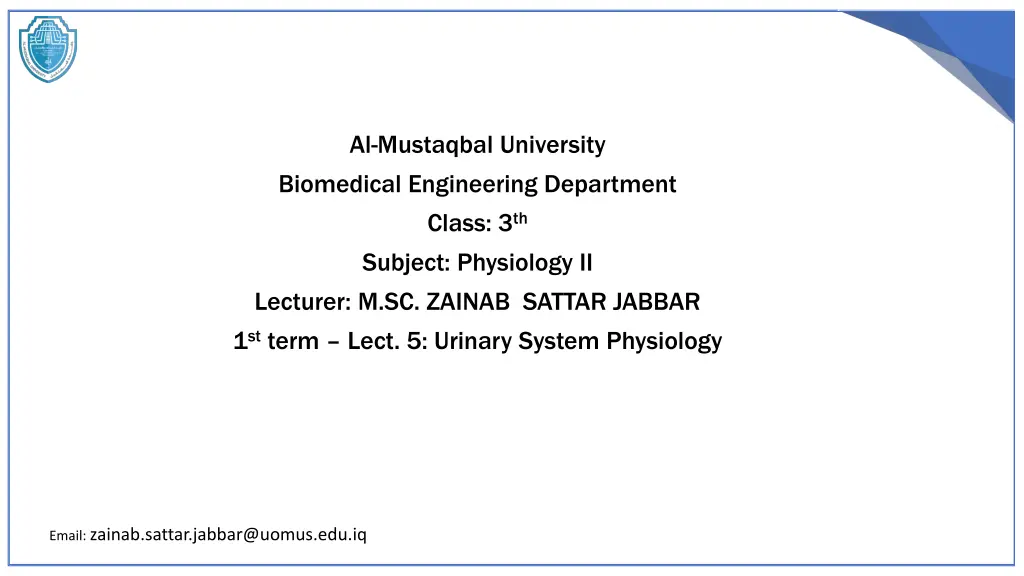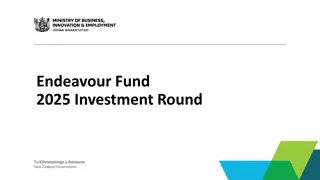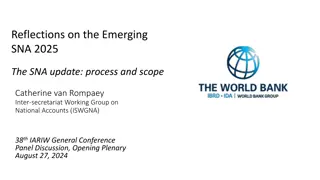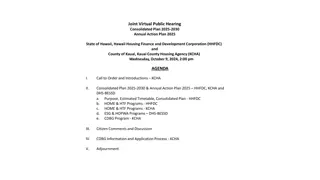
Understanding the Functions of the Urinary System in Physiology II
Explore the vital functions of the urinary system in Physiology II, including waste elimination, water and electrolyte balance regulation, arterial pressure maintenance, acid-base balance regulation, erythrocyte production, vitamin D synthesis, and glucose synthesis. Discover how the kidneys play a crucial role in maintaining overall health and homeostasis.
Uploaded on | 1 Views
Download Presentation

Please find below an Image/Link to download the presentation.
The content on the website is provided AS IS for your information and personal use only. It may not be sold, licensed, or shared on other websites without obtaining consent from the author. If you encounter any issues during the download, it is possible that the publisher has removed the file from their server.
You are allowed to download the files provided on this website for personal or commercial use, subject to the condition that they are used lawfully. All files are the property of their respective owners.
The content on the website is provided AS IS for your information and personal use only. It may not be sold, licensed, or shared on other websites without obtaining consent from the author.
E N D
Presentation Transcript
Al-Mustaqbal University Biomedical Engineering Department Class: 3th Subject: Physiology II Lecturer: M.SC. ZAINAB SATTAR JABBAR 1st term Lect. 5: Urinary System Physiology Email: zainab.sattar.jabbar@uomus.edu.iq
Urinary System The kidneys perform their most important functions by filtering the plasma and removing substances from the filtrate at variable rates, depending on the needs of the body. It is important to recognize that the kidneys serve multiple functions, including the following: 1. Excretion The kidneys are the primary means for eliminating waste products of metabolism that are no longer needed by the body. These products include urea (from the metabolism of amino acids), creatinine (from muscle creatine), uric acid (from nucleic acids), bilirubin (from hemoglobin breakdown), and metabolites of various hormones. The kidneys also eliminate most toxins and other foreign substances that are either produced by the body or ingested, such as pesticides, drugs, and food additives. 2. Regulation of Water and Electrolyte Balances Intake of water and many electrolytes is governed mainly by a person s eating and drinking habits, requiring the kidneys to adjust their excretion rates to match the intake of various substances.
Urinary System 3. Regulation of Arterial Pressure. The kidneys play a dominant role in long-term regulation of arterial pressure by excreting variable amounts of sodium and water. The kidneys also contribute to short-term arterial pressure regulation by secreting vasoactive factors or substances, such as renin, that lead to the formation of vasoactive products (e.g., angiotensin II). 4. Regulation of Acid-Base Balance. The kidneys contribute to acid-base regulation by excreting acids such as sulfuric acid and phosphoric acid, generated by the metabolism of proteins. 5. Regulation of Erythrocyte Production. The kidneys secrete erythropoietin, which stimulates the production of red blood cells. One important stimulus for erythropoietin secretion by the kidneys is hypoxia. In people with severe kidney disease or who have had their kidneys removed and have been placed on hemodialysis, severe anemia develops as a result of decreased erythropoietin production. 6. Regulation of vitamin D Production. The kidneys produce the active form of vitamin D which is essential for normal calcium deposition in bone and calcium reabsorption by the gastrointestinal tract. 7. Glucose Synthesis. The kidneys synthesize glucose from amino acids and other precursors during prolonged fasting, a process referred to as gluconeogenesis.
Renal Blood Supply Blood flow to the two kidneys is normally about 22 per cent of the cardiac output, or 1100 ml/min. The renal artery enters the kidney through the hilum and then branches progressively to form the interlobar arteries, arcuate arteries, interlobular arteries and afferent arterioles, which lead to the glomerular capillaries, that coalesce to form the efferent arteriole, which leads to a second capillary network, the Peritubular capillaries, that surrounds the renal tubules. High hydrostaticpressure in the glomerular capillaries (about 60 mm Hg) causes rapid fluid filtration, whereas a much lower hydrostatic pressure in the Peritubular capillaries (about 13 mm Hg) permits rapid fluid reabsorption. The Peritubular capillaries empty into interlobular vein, arcuate vein, interlobar vein, and renal vein, which leaves the kidney beside the renal artery and ureter.
Urine Formation The rates at which different substances are excreted in the urine represent the sum of three renal processes, 1. Glomerular filtration, and 2. Reabsorption of substances from the renal tubules into the blood, and 3. Secretion of substances from the blood into the renal tubules. Urinary excretion rate = Filtration rate - Reabsorption rate + Secretion rate Urine formation begins when a large amount of fluid that is virtually free of protein is filtered from the glomerular capillaries into Bowman s capsule. As filtered fluid leaves Bowman s capsule and passes through the tubules, it is modified by reabsorption of water and specific solutes back into the blood or by secretion of other substances from the Peritubular capillaries into the tubules.
Urine Formation If the substance shown in panel A is freely filtered by the glomerular capillaries but is neither reabsorbed nor secreted, therefore, its excretion rate is equal to the rate at which it was filtered, such as creatinine. In panel B, the substance is freely filtered but is also partly reabsorbed from the tubules back into the blood. Therefore, the excretion rate is calculated as the filtration rate minus the reabsorption rate. This is typical for many of the electrolytes of the body. In panel C, the substance is freely filtered at the glomerular capillaries but is not excreted into the urine because all the filtered substance is reabsorbed from the tubules back into the blood. Therefore, its excretion rate is equal to zero, such as amino acids and glucose. The substance in panel D is freely filtered at the glomerular capillaries and is not reabsorbed, but additional quantities of this substance are secreted from the peritubular capillary blood into the renal tubules. The excretion rate in this case is calculated as filtration rate plus tubular secretion rate which occurs for organic acids and bases.
Urine Formation Glomerular filtration rate (GFR) is the volume of fluid filtered from the renal glomerular capillaries into the Bowman's capsule per unit time. The GFR can be determined by injecting inulin into the plasma. Since inulin is neither reabsorbed nor secreted by the kidney after glomerular filtration, its rate of excretion is directly proportional to the rate of filtration of water and solutes across the glomerular filter. Therefore, the GFR is equal to the concentration of inulin in urine (Ui) times the urine flow per unit of time (V.) divided by the arterial plasma level of inulin (Pi), {GFR= Ui x V/ Pi}. The GFR in normal man is approximately 125 mL/min, but values in women are 10% lower than those in men. A rate of 125 mL/min is 7.5 L/h, or 180 L/d, whereas the normal urine volume is about 1 L/d. Thus, 99% or more of the filtrate is normally reabsorbed.
Renin-angiotensin-aldosterone system (RAAS) It is a hormone system that regulates blood pressure and water (fluid) balance. When blood volume is low, juxtaglomerular cells in the kidneys secrete renin. Renin stimulates the production of angiotensin I, which is then converted to angiotensin II. Angiotensin II causes blood vessels to constrict, resulting in increased blood pressure. Angiotensin II also stimulates the secretion of the hormone aldosterone from the adrenal cortex, that causes the tubules of the kidneys to increase the reabsorption of sodium and water into the blood. This increases the volume of fluid in the body, which also increases blood pressure. If the renin-angiotensin-aldosterone system is too active, blood pressure will be too high. There are many drugs that interrupt different steps in this system to lower blood pressure. These drugs are one of the main ways to control high blood pressure (hypertension), heart failure, kidney failure, and harmful effects of diabetes.
Micturition Also known as urination, and voiding, is the ejection of urine from the urinary bladder through the urethra to the outside of the body. The main organs involved in urination are the urinary bladder and the urethra. The urinary bladder is a smooth muscle chamber composed of two main parts: 1. The body, which is the major part of the bladder in which urine collects, its smooth muscle called the detrusor muscle. It is innervated by sympathetic and parasympathetic nerve fibers. When contracted, can increase the pressure in the bladder to 40 to 60 mm Hg. Thus, contraction of the detrusor muscle is a major step in emptying the bladder. 2. The neck, which is a funnel-shaped extension of the body, connecting with the urethra. The lower part of the bladder neck is also called the posterior urethra because of its relation to the urethra. The muscle in this area is called the internal sphincter that is also innervated by sympathetic and parasympathetic nerve fibers, and can prevents emptying of the bladder until the pressure in the body of the bladder rises above a critical threshold. Beyond the posterior urethra, there is a layer of muscle called the external sphincter of the bladder. This muscle is a voluntary skeletal muscle and can be used to consciously prevent urination even when involuntary controls are attempting to empty the bladder.
Micturition In healthy individuals, the muscles controlling micturition are controlled by the autonomic and somatic nervous systems, thus the lower urinary tract has two discrete phases of activity: 1) The storage phase, in which the internal urethral sphincter remains tense and the detrusor muscle relaxed by sympathetic stimulation, thus the bladder fills progressively until reaches its maximum volume (about 300-400 ml) and the tension in its walls rises above a threshold level; this elicits the second phase. 2) The voiding phase, in which parasympathetic stimulation causes the detrusor muscle to contract and the internal urethral sphincter to relax. The external urethral sphincter is under somatic control and is consciously relaxed during micturition. This is a nervous reflex called the micturition reflex that empties the bladder and urine is released through the urethra.
Micturition The micturition reflex is a completely autonomic spinal cord reflex, but it can be inhibited or facilitated by centers in the brain. These higher centers normally exert final control of micturition as follows: 1. The higher centers keep the micturition reflex partially inhibited, except when micturition is desired. 2. The higher centers can prevent micturition, even if the micturition reflex occurs, by continual contraction of the external bladder sphincter until a convenient time presents itself. 3. When it is time to urinate, the cortical centers can facilitate a micturition reflex and at the same time inhibit the external urinary sphincter so that urination can occur.






















